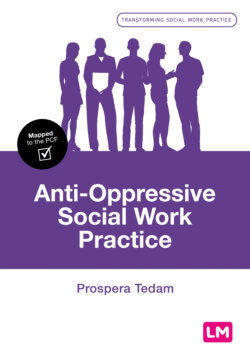Читать книгу Anti-Oppressive Social Work Practice - Prospera Tedam - Страница 20
На сайте Литреса книга снята с продажи.
Teaching and learning anti-oppressive practice
ОглавлениеIn this section, we will examine the way in which anti-oppression is taught on social work programmes and highlight the tensions that can be present in the classroom during such important teaching. There is a shared responsibility between you, the learner, and the educator to consciously and meticulously engage in learning that will enhance your practice in the future. Such learning is expected to be painful, uncomfortable and unsettling; however, it should not be used as a reason not to engage in these discussions (Boler and Zembylas, 2003).
Anti-oppressive practice seeks to negate or minimise the influence of oppression and recognises that oppression does not operate in a vacuum. Social work programmes are, and rightly so, one of the main sites where knowledge and understanding of anti-oppressive practice is valued and taught. There is no clearly defined approach to teaching anti-oppressive practice content in social work programmes around the world; however, there are some principles that can and should permeate all social work programmes. Smith (2010) warns against tokenistic attempts to include marginalised voices in teaching. There is an abundance of literature about the experiences of faculty teaching curriculum on anti-oppression within social work programmes (Chand et al., 2002; Coxshall, 2020) and the research summary below explores this further.
Research Summary
Twenty-one years ago, Coleman et al. (1999), writing about their experiences of teaching anti-oppressive practice to students enrolled on the Diploma in Social Work (DipSW), concluded that there is a need to address not only the cognitive elements of learning, but also the emotional elements involved in teaching about oppression. They also challenged the intentional and unintentional hierarchical approach to teaching oppression in the classrooms and bemoaned the fact that some students were prone to dissociation. Importantly, the research highlighted the traumatic experiences for students and educators in relation to the content of anti-oppressive practice classes, as well as the discussions and debates these generated in the classroom. For example, a student who identified as lesbian attended a mental health class, only to be given a handout in which homosexuality was identified as a personality disorder. This experience is an example of oppression which is damaging and traumatic. This reminds us of Barker’s (2003) reference to being devalued as an element of oppression, so, as social work students, you are encouraged to challenge such overt oppression in constructive ways.
Gibson (2014, p204) has argued that social work students’ emotional-affective feelings about groups that are different to their own is a significant barrier to their learning about social justice and oppression. The teaching content, she argues, is almost always so personal that educators need to be aware of and prepared to address emotional needs, as well as conflicting values and beliefs. In so doing, the model requires social work educators themselves to create an atmosphere of safety by explaining thoroughly the rationale for the discrete areas of teaching. This will go some way to minimise anxiety and discomfort within the classroom, and should result in them being able to transfer this knowledge and behaviour to their various practice settings.
Coxshall (2020) outlines her use of critical race theory as a pedagogic tool and suggests that there are case studies in the recent British history (such as the Grenfell Tower disaster) that students can read about to raise their awareness of oppression, inequality and discrimination.
